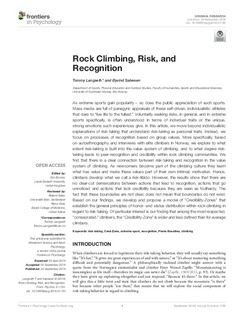| dc.contributor.author | Langseth, Tommy | |
| dc.contributor.author | Salvesen, Øyvind | |
| dc.date.accessioned | 2019-01-17T12:28:07Z | |
| dc.date.available | 2019-01-17T12:28:07Z | |
| dc.date.created | 2018-12-19T11:42:32Z | |
| dc.date.issued | 2018 | |
| dc.identifier.citation | Frontiers in Psychology. 2018, 9 . | nb_NO |
| dc.identifier.issn | 1664-1078 | |
| dc.identifier.uri | http://hdl.handle.net/11250/2581084 | |
| dc.description | This is an open-access article distributed under the terms of the Creative Commons Attribution License (CC BY). The use,distribution or reproduction in other forums is permitted, provided the original author(s) and the copyright owner(s) are credited and that the original publication in this journal is cited, in accordance with accepted academic practice. No use, distribution or reproduction is permitted which does not comply with these terms. | nb_NO |
| dc.description.abstract | As extreme sports gain popularity – so does the public appreciation of such sports. Mass media are full of panegyric appraisals of these self-driven, individualistic athletes that dare to “live life to the fullest.” Voluntarily seeking risks, in general, and in extreme sports specifically, is often understood in terms of individual traits or the unique, strong emotions such experiences give. In this article, we move beyond individualistic explanations of risk-taking that understand risk-taking as personal traits. Instead, we focus on processes of recognition based on group values. More specifically, based on autoethnography and interviews with elite climbers in Norway, we explore to what extent risk-taking is built into the value system of climbing, and to what degree risktaking leads to peer-recognition and credibility within rock climbing communities. We find that there is a clear connection between risk-taking and recognition in the value system of climbing. As newcomers become part of the climbing culture they learn what has value and make these values part of their own intrinsic motivation. Hence, climbers develop what we call a risk-libido. However, the results show that there are no clear-cut demarcations between actions that lead to recognition, actions that go unnoticed and actions that lack credibility because they are seen as foolhardy. The fact that these boundaries are not clear, does not mean that boundaries do not exist. Based on our findings, we develop and propose a model of “Credibility-Zones” that establish the general principles of honor- and status distribution within rock-climbing in regard to risk-taking. Of particular interest is our finding that among the most respected, “consecrated,” climbers, the “Credibility-Zone” is wider and less defined than for average climbers. | nb_NO |
| dc.description.abstract | Rock climbing, risk, and recognition | nb_NO |
| dc.language.iso | eng | nb_NO |
| dc.rights | Navngivelse 4.0 Internasjonal | * |
| dc.rights.uri | http://creativecommons.org/licenses/by/4.0/deed.no | * |
| dc.title | Rock climbing, risk, and recognition | nb_NO |
| dc.type | Journal article | nb_NO |
| dc.type | Peer reviewed | nb_NO |
| dc.description.version | publishedVersion | nb_NO |
| dc.rights.holder | © 2018 Langseth and Salvesen | nb_NO |
| dc.source.pagenumber | 10 | nb_NO |
| dc.source.volume | 9 | nb_NO |
| dc.source.journal | Frontiers in Psychology | nb_NO |
| dc.identifier.doi | 10.3389/fpsyg.2018.01793 | |
| dc.identifier.cristin | 1645513 | |
| cristin.unitcode | 222,59,4,0 | |
| cristin.unitname | Institutt for friluftsliv, idrett og kroppsøving | |
| cristin.ispublished | true | |
| cristin.fulltext | original | |
| cristin.qualitycode | 2 | |

